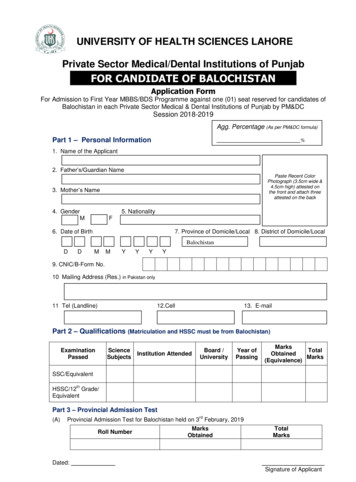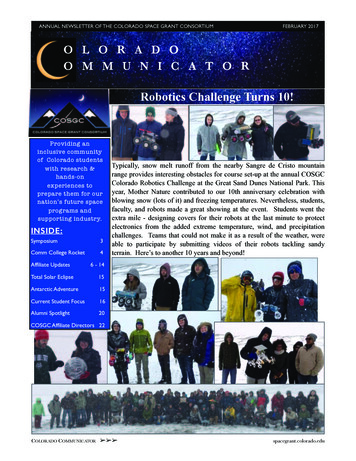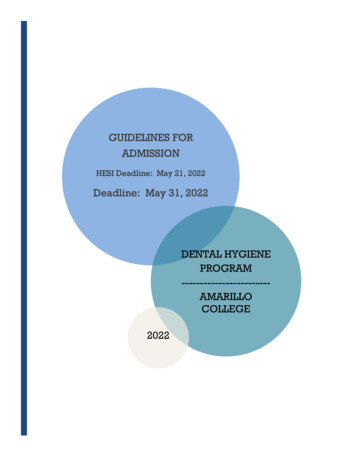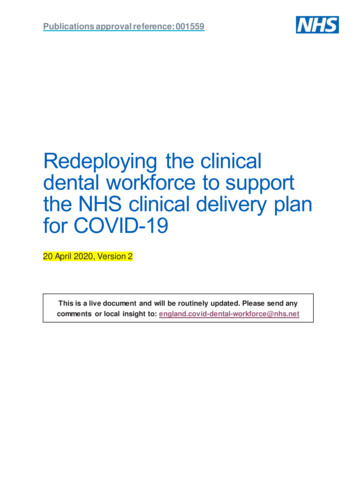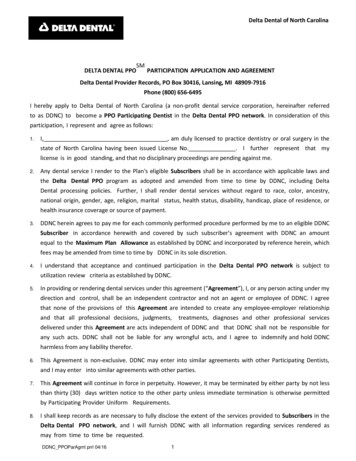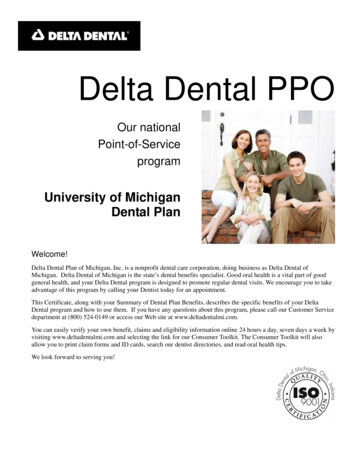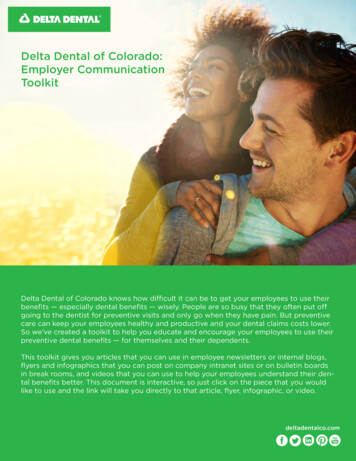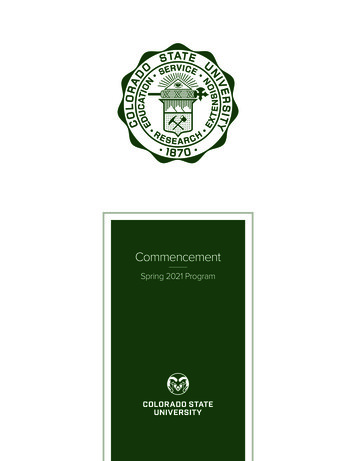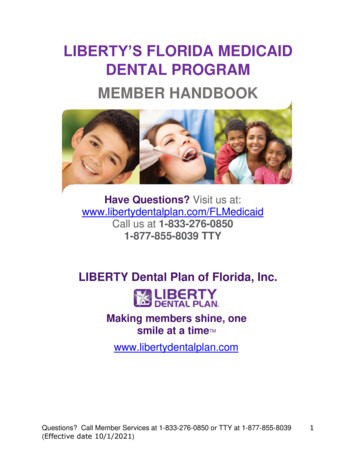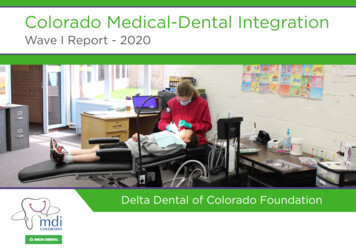
Transcription
Colorado Medical-Dental IntegrationWave I Report - 2020Delta Dental of Colorado Foundation
2Wave I beganin 2015 withExecutive SummaryDelta Dental of Colorado Foundation launched the Colorado Medical-Dental IntegrationProject (CO MDI) in 2015 to expand access to dental services for populations who experiencedlimited access to dental care due to insurance status, location, and transportation barriers.28 RDHsintegrated intoCO MDI supported an innovative care model that integrates medical and dental care byplacing registered dental hygienists (RDHs) in medical settings. CO MDI’s first wave began in2015 with twenty-eight RDHs integrated into 18 practices within 16 healthcare organizations.By March 2019, hygienists in the 12 organizations that completed Wave I provided morethan 67,000 hygiene visits, expanding access to oral health care and improving oral healthoutcomes for historically underserved Coloradans of all ages.Foundation funding included grants to the participating practices, support for a CO MDILearning Network, practice transformation activities, and a robust Institutional Review Boardevaluation. The evaluation was led by Patricia A. Braun, MD, MPH through the Adult andChild Consortium for Research and Delivery Science at the University of Colorado. Dr. Braunis a national expert on pediatric oral health with a strong research and evaluation record. Theinformation in this report draws heavily on Dr. Braun’s evaluation findings for Wave I.18 siteswithin16 healthcareorganizationsDr. Braun (center) converses with grantees at a CO MDI Learning Network Session.
3Why CO MDI?CONNECTING ORAL ANDOVERALL HEALTHOral health is a critical component of overall health. Research clearly demonstrates that the mouth isa window to the body. Improving oral health reduces the risk of serious physical conditions, includingtooth decay, diabetes and heart disease. A healthy mouth absent of pain also contributes to goodmental health and is foundational for employment and one’s ability to learn in school. Yet too manyColoradans go without regular oral health care, especially those with lower incomes and those living inrural communities.Doctor’s CareDental and medical professions have traditionally been separated from one another from education andtraining to payment and practice. This creates challenges to integrating oral health into medical care.Workforce efforts to date have reinforced, not resolved, the siloes between medical and oral health.Delta Dental of Colorado Foundation funded CO MDI, recognizing that Coloradans more commonlyvisit the medical office than the dental office.CO MDI is an innovative project to expand access to dental services by integrating medical and dentalcare in medical care practices for populations who experienced limited access to dental care due toinsurance status, location, and transportation barriers.Higher-earning Coloradans were more likely to visit the dentist61.2%82.7%of Coloradans earning 134% of the FPL visited adental provider in 2019of Coloradans earning 400% of the FPL visiteda dental provider in 20192019 Colorado Health Access SurveyPeople living in South and Northeast Coloradowere less likely to visit a dental professional58.6%Alamosa, Conejos, Costilla, Mineral, RioGrande, and Saguache counties59.9%Logan, Morgan, Phillips, Sedgwick,Washington, and Yuma counties73.6%of all Coloradans73.6% of all Coloradans visited a dental professional in 2017, up from 65.3% in 2013.2019 Colorado Health Access SurveyColoradans earning below134% of Federal Poverty Level(FPL) are eligible for ColoradoMedicaid, which includes dentalbenefits for all enrollees.“A woman was scheduled for anew patient physical and a dentalcleaning appointment in the samevisit. She informed us that she hadfelt like she has something stuck inher throat for at least the last twomonths and it would not go away.Our dental hygienist then saw thepatient for her preventive cleaningappointment. During her head,neck and oral cancer exam thehygienist noted a 4mm round masson the patient’s right anterior tonsil.The hygienist showed the medicalprovider the mass and a referralwas made to Care Coordination.Within just a few hours, the CareCoordinator referred the patient toan Ear, Nose and Throat specialistthat accepts Medicaid. Thespecialist removed the mass.”
4CO MDI WAVE IFAST FACTS16initial granteeswith12WHY CO MDI? (continued)21 sites.grantees completedWave I in18 sites.4 grantees droppedout over the courseof the program.28 integrated dentalhygienists participatedin CO MDI.67,092 integrateddental hygiene visitsprovided by Wave ICO MDI hygienists.The overarching goal of the CO MDI Project included:1. Expand access to dental services.2. Improve oral health outcomes of CO MDI populations.3. Build financially-sustainable CO MDI models.These goals align closely with Delta Dental of Colorado Foundation’s long-term focus of ensuring allColoradans have access to oral health care, that services are available to prevent tooth decay and thatoral health is recognized as a critical part of overall health care.CO MDI embodies the foundations of success identified in Delta Dental of Colorado Foundation’stheory of change. The project aims to address workforce gaps by supporting innovative models ofcare; provides direct services to Coloradans facing the greatest barriers to accessing oral health careand prevention services; and creates affordable options for patients. The model – led by RDHs who aretrained in oral health prevention and education – also provides critical education and awareness formany caregivers and children on the importance of oral health care.Not only does CO MDI provide much-needed oral health care services, the project is continuously beingevaluated for its impact and adding to the body of research that integrated RDHs are an effectivemeans of improving the oral health, and ultimately, the well-being of all Coloradans.Coloradans were more likely to visit the doctor than a dental providerColoradans whosaw a doctor87.6%201973.6%01M2M3M4MColoradans who saw adentist or dental hygienist5M2019 Colorado Health Access Survey85%Coloradansreporting goodor excellentgeneral health81.6%2019 Colorado Health Access SurveyColoradansreporting goodor excellentoral health
5What is CO MDI: HistoryMORE DENTAL VISITS,LESS UNTREATED DECAYCO MDI places RDHs into medical care teams, where RDHs offer full-scope preventiveoral health services on-site in medical practices. By integrating the RDHs into the careteam, they become part of the healthcare community and also coordinate referrals toco-located dentists (when available) or outside community dentists to get people therestorative dental care they need.Worthmore clinicDelta Dental of Colorado Foundation supported co-location of RDHs into medicalpractices in five clinics from 2008 through 2011. The feasibility of co-locating RDHswas studied. The results showed that co-locating RDHs into medical practices was notonly feasible, but an innovative model to provide preventive oral health services todisadvantaged children.Building off this initial success, Colorado healthcare organizations were invited toapply to participate in CO MDI in 2014. A total of 18 organizations applied. Sixteenorganizations were selected to participate in Wave I, with four grantees dropping outover the course of the program.Ten organizations were awarded Wave II grants in 2018. Wave II began in 2019 andruns through April 2022. Twenty-six organizations in total have been awarded grantsthat serve 39 different locations across Colorado. These practices span beyond just theDenver metro area, and touch the four corners of the state. CO MDI supports integratedpractices from La Junta in southeast Colorado to Holyoke in the northeast, to Craig inthe northwest and Durango in the southwest.CO MDI locationsWave IWave IIDuring the project period, the prevalence ofWorthmore Clinic patients receiving a dental visitin the last year improved from between 55-80%at the beginning of the project to 75-90% at theconclusion. Patients of all ages had a significantdecline in untreated decay, from 75-40% (basedon age) at the beginning to 40-20%.“A refugee from Nepal came to our clinic afterundergoing a secondary resettlement fromArizona, where he was originally resettled. Forseveral months, he had been trying to findemployment, but believed himself unemployablebecause of the condition of his oral hygiene.He was missing many of his teeth and had severedecay in those that remained. We were able toconduct a full mouth extraction and place full topand bottom dentures.He recently came back to theclinic to talk, smile, and let usknow that he had found workin a luxury hotel in Denver.We have seen the incredibleimprovements in dental andoverall health, as well as therestoration of a dignity that wasonce thought to be lost. This iswhat we are most proud of andwhat motivates us to continueto grow and reach more lives.”
6INNOVATIONCO MDI has generated nationalinterest as one-of-a-kind acrossthe country. The American DentalHygiene Association has kept asteady pulse on the progress of theproject as well as stakeholders inother states. Other states includingPennsylvania, Florida, Wisconsin,Minnesota, Oregon, and Florida aretesting the integration of dentalhygienists into medical care teamsand using CO MDI as an importantresource.WHAT IS CO MDI: HISTORY (continued)CO MDI evolved from the Foundation’s early support of co-location, with an emphasis on addressingthe medical and dental systems that historically separated oral health from overall health, includingbilling, scheduling, and clinical workflow.In Colorado, the scope of work of RDHs is broad, which allows hygienists to provide a wide array ofservices. For example, Colorado is one of only two states (with Oregon) that allow hygienists to diagnoseoral conditions within their scope of practice as part of a hygiene treatment plan. Colorado is one ofeight states that allows prescriptive authority for RDHs. In addition to direct access practice, hygienistsin Colorado are able to administer anesthesia with indirect supervision, sealants, x-rays, provide dentalhygiene diagnosis, limited prescriptive authority and now interim therapeutic restorations (ITR) andsilver diamine fluoride (SDF), and more.A key element to the success of the CO MDI program was technical assistance (TA). Organizationsreceived TA to develop a hygiene space and participated in a Learning Network, which included biannualcollaborative day-long sessions and location-specific practice transformation coaching using projectmetrics and continuous quality improvement approaches to help with building integrated models.By end of Wave I in March 2019, 12 grantees remained in the cohort offering integrated care at 18practices with 28 RDHs.
7Measuring ImpactREDUCING TIMEBETWEEN DENTAL VISITSCO MDI successfully integrated RDHs into medical teams as an innovate approach to increase access tooral health services. The model provided patients with alternative access to oral health services.Northwest Colorado HealthCO MDI expanded access to dental careCO MDI’s Wave I hygienists delivered more than 67,000 integrated hygiene visits since September 2015through March 2019. Seventy percent of visits with individuals enrolled in Medicaid and 24 percent (oneof four) for those without insurance. In addition, these hygienists provided over 34,000 referrals todentists for untreated dental decay among the individuals they saw.CO MDI provided dental hygiene care to a broad spectrum of individuals across the lifespan. CO MDI’sinitial goal was to reach young children. This changed early in the project to improve access to care forall patients being seen in the medical practice. Forty percent of visits were with adults over age 19 and27 percent with children ages 5 and below.Additionally, across all visits, almost half (45 percent) of the patients had not had a dental visit in morethan a year.Care provided by CO MDI Wave I RDHs: September 2015 – March 201967,092integrated dentalhygiene visitsAdults 19 40%referrals to dentists foruntreated dental decayCO MDI encounters by insurance typeChildren 527%Children 6-1833%34,157CO MDIencounters byage70% Medicaid24% Uninsured6% CHP and/or privateNorthwest Colorado Health hada significant improvement inthe proportion of CO MDI visitswith a past dental visit within thepast year across all ages Amongchildren ages 0 to 5, the proportionincreased from less than 10 percentto over 60 percent during theproject period.“At 15 years old, Andrew had neverbrushed his teeth. Unable to takethe pain in his mouth, he beggedhis mother to take him to thedentist. The day he came to ouroffice, we gave Andrew his firsttoothbrush and showed him howto brush his teeth. We were ableto give Andrew the education andtools to take care of his teeth, alife-changing experience.”
8IMPROVINGDISEASE OUTCOMESMEASURING IMPACT (continued)Colorado Coalitionfor the HomelessCO MDI impacted oral health outcomes“A family displaced by HurricaneMichael came to Colorado withthe hopes of employment for themother, as the father is disabled.They came to our Stout Streetlocation for a pediatric visit, seekingroutine paperwork so their 3 kids,ages 6, 8, and 11, could enter school.We did a dental screening for thechildren and were able to identify theneed for sealants and urgent dentalcare. That same day, staff scheduledthem and did all of the needed work.The parents were very grateful, andthought that dental care would haveto be an afterthought to care, asthey didn’t have means to travel “allover town” to get dental care fortheir family.That was three years ago, and we’rehappy to report that the motherand all three of the children receiveroutine care and have no outstandingdecay. They have restored mouths,and restored family. The mother notonly got a job, but was granted apromotion, and the family is housedand getting back on their feet.”Approximately half (51 percent) of CO MDI patient visits with the RDHs had untreated dental decay (atleast one cavity). The prevalence of patient visits with untreated dental decay declined over the span ofthe project in many of the CO MDI practices. While influences within and around the medical practicesmay have had a role in reducing the percent of CO MDI visits with untreated decay, the evaluationsuggests the association of CO MDI visits with improved oral health outcomes (specifically untreateddental decay).Patients did at times struggle to access the type of care provided by dentists, sometimes referred to asrestorative care, including dental procedures. Only about one-third of the participating practices had adentist on-site, and interview information suggested that on-site dentists didn’t have sufficient capacityto see additional patients. Never-the-less, over half (55%) of referrals to a dentist for untreated dentaldecay were completed.CO MDI practices were asked to track referrals for six months, so this is likely an undercount. Trackingreferrals had inherent challenges, especially in systems without integrated medical-dental health records.Other challenges to tracking referrals included a lack of communication from outside dentists to learnif patients did visit, and challenges in contacting patients to learn if they attended the dental referral.RDHs and practice leaders interviewed expressed frustration at not being able to get patients in forrestorative services with a dentist. On occasion, they would see patients return with untreated decay.The prevalence ofperiodontal disease amongthe often-disadvantagedadult patients served bythe Colorado Coalition forthe Homeless hit a highof near 90 percent duringthe project, but trendeddownward to 70 percentover the project period.
9Critical Success FactorsADDRESSING UNTREATED DECAYThe CO MDI Wave I evaluation identified critical success factors for adopting the modelthrough interviews with practice leaders and administrators:The prevalence of untreated dental decayamong children seen by the CO MDI RDHat Valley-Wide Health Systems substantiallyimproved throughout the project with ratesas high as 50-80% (based on age) to less than20%. Untreated dental decay among adultsshowed improvement in the last project year.Leadershipsupport ssesCommitmentto integrationFavorable dentalhygienistsTeamapproachValley-Wide Health SystemDentalexperiencePatientsatisfactionThree major themes emerged as organization-level facilitators – leadership support andbuy-in for the program; commitment to integration and integrated care delivery models,which was more common for the participating Federally Qualified Health Centers withincentives to achieve greater levels of integration; and previous dental experience, frombilling and equipment to service delivery, within the organization.Practice-level facilitators included team-based approaches to sustain awarenessand collaboration; efficient workflows; and motivated hygienists with exceptionalcommunications and interpersonal skills. RDHs also proved critical to patient retention byestablishing relationships and serving as an on-site dental resource.Some of the challenges cited by administrators included billing and insurance issues;moving staff culture toward integration; and limited on-site restorative dental services as afactor in patient retention.“When I talk to patients, the enthusiasm, whether they’regetting dental for themselves or their children, is really high.I think the simplicity of having dental as a part of a well visit—a part of preventive and well care—has been successful.”-CO MDI practice CEO“A patient at our La Junta Clinic was scheduledfor a heart procedure, but the surgeoncancelled the surgery because of the patient’smouth. The surgeon was concerned that thepatient’s oral disease would compromiserecovery and requested that the patient’soral health issues be taken care prior torescheduling the surgery.The patient didn’t have insurance, but ourdental patient navigator and program financialeligibility specialist found that they qualifiedfor financial assistance through Valley-WideHealth Systems. The patient was scheduledwith our dental hygienist the followingweek, and after a screening and x-rays, wasscheduled with a dentist the following day.Dental treatment was completed at the endof June and the patient’s heart surgery wasrescheduled for the beginning of July. Theeligibility assistance, comprehensive examand dental treatment were completed withinthree weeks. The medical doctor, hygienist,dentist, navigator, dental support staff, andeligibility specialist brought together theirtalents to provide timely services and ensureour patient’s well-being.”
10FINDING ADAPTABLEHYGIENISTSCRITICAL SUCCESS FACTORS (continued)Denver Health and Hospitals Foundation“The last three years with the MDI programhave shown me the most growth in not onlyprofessional but also personal life. I found my“calling” working with low-income childrenand families.The first three months, I had no equipment.This gave me the chance to learn processes,see where needs were, start to form processmaps and meet the staff. We had manymeetings where pediatrics, obstetrics, dental,clerical, leadership, DDCOF, and CDPHEcame together to brainstorm our project!The MDI project grew my administrative skillswith creating meeting minutes, metrics, onlinemeetings, communication between severaldepartments, and stepping up as a leader inour clinic. My clinical skills excelled as I waspracticing as an independent. Althoughthere was a dentist a few floors away, Ineeded to grow confidence in my ownknowledge and skills.CO MDI RDHs also shared their perspectives on critical success factors. These included RDHcharacteristics that emphasized adaptation, problem solving, and meeting patients wherethey are. Practice-level supports include supportive practice leaders, especially aroundscheduling and billing as well as delegation across a care team.RDHs also identified challenges including limited on-site restorative services (describedearlier in this report) and feeling like a solo practitioner. Scheduling processes that wereseparate from medical scheduling also created barriers to integration.All interviewees highlighted several systems-level factors that impacted the program’ssuccess. These included having dental insurance, especially for low-income patients; dentalinsurance billing knowledge; and insurance reimbursement for CO MDI services.For example, RDHs expressed frustration with providing dental hygiene services that werenot reimbursed, sometimes due to changes in the dental insurance benefit or a change inpatient insurance coverage, but also due to limited knowledge at the practices about how toaccurately submit dental insurance claims.The relationships I formed were invaluable,not only within the Eastside Clinic but withour external partnerships. I have becomea ‘go-to’ for the Colorado Dental HygieneAssociation for my work and knowledgein the integration model. My life has beenchanged by the opportunity to work withthe CO MDI model and I am forever grateful.”- JESSICA JENSENJessica Jensen (left) at the Eastside Clinic.
Program PerceptionsMedical providers from CO MDI practices completed surveys several times during theproject, providing feedback on their oral health knowledge, attitudes, beliefs, and behaviors.Overall medical providers had very favorable attitudes toward CO MDI throughout theproject and felt strongly about the importance of oral health for their patients’ health andwell-being.Importantly, more providers reported being able to assess theirpatients’ risks for oral health disease after participating in COMDI for two years than at the initiation of the program.Among respondents of a sample of CO MDI patients surveyed about their care, mostpatients/parents agreed it was convenient to get care from a RDH in a medical setting andthat they were more likely to see a RDH in a medical office than a dental office.Investing in the model of COMDI Financial Metrics - Wave IRevenue positive (accounting for grant anda portion of outstanding claims paid) bythe 3rd or 4th year, out of 12 organizationsthat completed the program12.3M.9M 8NSTIOZA 3NIGAORInvested in CO MDI Wave IBillable oral health servicesgenerated by Wave I grantees11CO MDI COACHESCO MDI practice coaches provedkey to many of the program’ssuccess factors. Practice coacheskept leaders engaged with thedevelopment of workflows andaware of problems, helped teamswith keeping CO MDI on thepractice’s agenda, and broughtresources to the teams whenneeded. Initially, practices neededtechnical assistance and coachingsupport for hiring the right RDHand buying equipment. Later,practices needed support withdeveloping workflows, identifyingprocesses to route patients to theRDH, and successfully gettingdental claims paid.
The Future of CO MDITen grantees are currently in the second year of CO MDI Wave II with grant support from Delta Dentalof Colorado Foundation and the Colorado Health Foundation. The evaluation of that work runs untilApril 2022.In 2019, integrated care practices participating in Wave II:Had 5,132 visits, including 2,991 patient-visits with Medicaid coverage, accounting forover half (58 percent) of all patient-visits in 2019. Over one quarter (29 percent) ofpatient-visits in 2019 were without dental insurance (1,500 patient-visits). The rate ofuninsured visits is slightly higher in 2019 than in previous years.Provided integrated dental care in 10 different settings across the state, including sixrural communities.Provided 365 pregnant women with dental hygiene services.To capture its success, Delta Dental of Colorado Foundation is beginning to establish best practices.Evaluation results informed the development of the CO MDI Toolkit and CO MDI Change Package.This is a “how-to” guide based on the experiences of CO MDI Wave I. This resource is for Coloradomedical practices interested in replicating the model to improve oral health of their patients. Many ofthese resources are applicable across state lines.The CO MDI Toolkit helped inform Wave II work and the work of others testing similar models. Theseproducts are now recognized nationally and are being utilized in the Maternal Child Health Bureau,Health Services Resource Administration Networks for Oral Health Integration within the Maternal andChild Health Safety Net. This five-year initiative (Sept 2019 - August 2024) will benefit from the COMDI products and evaluation findings.Delta Dental of Colorado Foundation is currently assessing whether to launch a Wave III, using 2020for planning and decision-making. One element of the assessment includes the extent to whichsolutions to key challenges, specifically through dental insurance coverage, can be addressed ormitigated through Delta Dental of Colorado and future policy decisions within Medicare, Health FirstColorado (Colorado’s Medicaid Program), and the Child Health Plan Plus.Colorado Health Institute. Colorado Health Access Survey. HAS.Braun, P. A., Kahl, S., Ellison, M. C., Ling, S., WidmerRacich, K., & Daley, M. F. (2013). Feasibility of co-locating dentalhygienists into medical practices. Journal of public health dentistry, 73(3), 187-194.Variation in Dental Hygiene Scope of Practice by State. 2019. Oral Health Workforce Research -state/12RESOURCE LISTAccess more information anddata on oral health in Colorado,by visiting the Delta Dental ofColorado Foundation resourcepage.ACKNOWLEDGMENTSData and evaluation findings citedin this report are from Patricia A.Braun, MD, MPH with the Adult andChild Consortium for Research andDelivery Science at the Universityof Colorado.Thank you to Patty Braun and herteam, and the Colorado HealthInstitute for guidance and expertiseon this report.
Delta Dental of Colorado Foundation funded CO MDI, recognizing that Coloradans more commonly visit the medical office than the dental office. CO MDI is an innovative project to expand access to dental services by integrating medical and dental care in medical care practices for populations who experienced limited access to dental care due to


